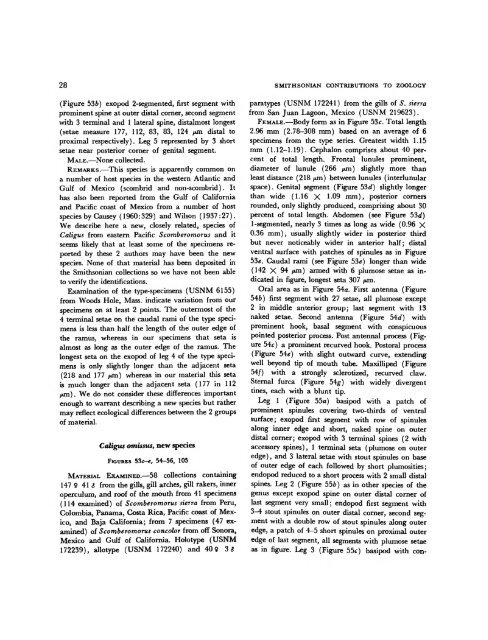Parasitic Copepods of Mackerel - and Tuna-like Fishes (Scombridae ...
Parasitic Copepods of Mackerel - and Tuna-like Fishes (Scombridae ...
Parasitic Copepods of Mackerel - and Tuna-like Fishes (Scombridae ...
You also want an ePaper? Increase the reach of your titles
YUMPU automatically turns print PDFs into web optimized ePapers that Google loves.
28 SMITHSONIAN CONTRIBUTIONS TO ZOOLOGY<br />
(Figure 536) exopod 2-segmented, first segment with<br />
prominent spine at outer distal corner, second segment<br />
with 3 terminal <strong>and</strong> 1 lateral spine, distalmost longest<br />
(setae measure 177, 112, 83, 83, 124 fim distal to<br />
proximal respectively). Leg 5 represented by 3 short<br />
setae near posterior corner <strong>of</strong> genital segment.<br />
MALE.—None collected.<br />
REMARKS.—This species is apparently common on<br />
a number <strong>of</strong> host species in the western Atlantic <strong>and</strong><br />
Gulf <strong>of</strong> Mexico (scombrid <strong>and</strong> non-scombrid). It<br />
has also been reported from the Gulf <strong>of</strong> California<br />
<strong>and</strong> Pacific coast <strong>of</strong> Mexico from a number <strong>of</strong> host<br />
species by Causey (1960:329) <strong>and</strong> Wilson (1937:27).<br />
We describe here a new, closely related, species <strong>of</strong><br />
Caligus from eastern Pacific Scomberomorus <strong>and</strong> it<br />
seems <strong>like</strong>ly that at least some <strong>of</strong> the specimens reported<br />
by these 2 authors may have been the new<br />
species. None <strong>of</strong> that material has been deposited in<br />
the Smithsonian collections so we have not been able<br />
to verify the identifications.<br />
Examination <strong>of</strong> the type-specimens (USNM 6155)<br />
from Woods Hole, Mass, indicate variation from our<br />
specimens on at least 2 points. The outermost <strong>of</strong> the<br />
4 terminal setae on the caudal rami <strong>of</strong> the type specimens<br />
is less than half the length <strong>of</strong> the outer edge <strong>of</strong><br />
the ramus, whereas in our specimens that seta is<br />
almost as long as the outer edge <strong>of</strong> the ramus. The<br />
longest seta on the exopod <strong>of</strong> leg 4 <strong>of</strong> the type specimens<br />
is only slightly longer than the adjacent seta<br />
(218 <strong>and</strong> 177 /*m) whereas in our material this seta<br />
is much longer than the adjacent seta (177 in 112<br />
/*m). We do not consider these differences important<br />
enough to warrant describing a new species but rather<br />
may reflect ecological differences between the 2 groups<br />
<strong>of</strong> material.<br />
Caligus omissus, new species<br />
FIGURES 53c-e, 54-56, 105<br />
MATERIAL EXAMINED.—58 collections containing<br />
147 9 41 S from the gills, gill arches, gill rakers, inner<br />
operculum, <strong>and</strong> ro<strong>of</strong> <strong>of</strong> the mouth from 41 specimens<br />
(114 examined) <strong>of</strong> Scomberomorus sierra from Peru,<br />
Colombia, Panama, Costa Rica, Pacific coast <strong>of</strong> Mexico,<br />
<strong>and</strong> Baja California; from 7 specimens (47 examined)<br />
<strong>of</strong> Scomberomorus concolor from <strong>of</strong>f Sonora,<br />
Mexico <strong>and</strong> Gulf <strong>of</strong> California. Holotype (USNM<br />
172239), allotype (USNM 172240) <strong>and</strong> 40$ 3*<br />
paratypes (USNM 172241) from the gills <strong>of</strong> S. sierra<br />
from San Juan Lagoon, Mexico (USNM 219623).<br />
FEMALE.—Body form as in Figure 53c. Total length<br />
2.96 mm (2.78-308 mm) based on an average <strong>of</strong> 6<br />
specimens from the type series. Greatest width 1.15<br />
mm (1.12-1.19). Cephalon comprises about 40 percent<br />
<strong>of</strong> total length. Frontal lunules prominent,<br />
diameter <strong>of</strong> lunule (266 /*m) slightly more than<br />
least distance (218 /*m) between lunules (interlunular<br />
space). Genital segment (Figure 53d) slightly longer<br />
than wide (1.16 X 1-09 mm), posterior corners<br />
rounded, only slightly produced, comprising about 30<br />
percent <strong>of</strong> total length. Abdomen (see Figure 53d)<br />
1-segmented, nearly 3 times as long as wide (0.96 X<br />
0.36 mm), usually slightly wider in posterior third<br />
but never noticeably wider in anterior half; distal<br />
ventral surface with patches <strong>of</strong> spinules as in Figure<br />
53*. Caudal rami (see Figure 53e) longer than wide<br />
(142 X 94 fixn) armed with 6 plumose setae as indicated<br />
in figure, longest seta 307 /*m.<br />
Oral area as in Figure 54a. First antenna (Figure<br />
546) first segment with 27 setae, all plumose except<br />
2 in middle anterior group; last segment with 13<br />
naked setae. Second antenna (Figure 54rf) with<br />
prominent hook, basal segment with conspicuous<br />
pointed posterior process. Post antennal process (Figure<br />
54c) a prominent recurved hook. Postoral process<br />
(Figure 54e) with slight outward curve, extending<br />
well beyond tip <strong>of</strong> mouth tube. Maxilliped (Figure<br />
54/) with a strongly sclerotized, recurved claw.<br />
Sternal furca (Figure 54g) with widely divergent<br />
tines, each with a blunt tip.<br />
Leg 1 (Figure 55a) basipod with a patch <strong>of</strong><br />
prominent spinules covering two-thirds <strong>of</strong> ventral<br />
surface; exopod first segment with row <strong>of</strong> spinules<br />
along inner edge <strong>and</strong> short, naked spine on outer<br />
distal corner; exopod with 3 terminal spines (2 with<br />
accessory spines), 1 terminal seta (plumose on outer<br />
edge), <strong>and</strong> 3 lateral setae with stout spinules on base<br />
<strong>of</strong> outer edge <strong>of</strong> each followed by short plumosities;<br />
endopod reduced to a short process with 2 small distal<br />
spines. Leg 2 (Figure 556) as in other species <strong>of</strong> the<br />
genus except exopod spine on outer distal corner <strong>of</strong><br />
last segment very small; endopod first segment with<br />
3-4 stout spinules on outer distal corner, second segment<br />
with a double row <strong>of</strong> stout spinules along outer<br />
edge, a patch <strong>of</strong> 4-5 short spinules on proximal outer<br />
edge <strong>of</strong> last segment, all segments with plumose setae<br />
as in figure. Leg 3 (Figure 55c) basipod with con-

















